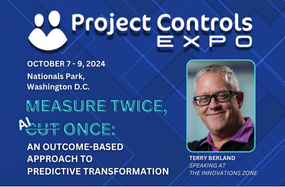
Death by a Thousand Cuts: Why Projects Fail (And How Tech Leaders Can Stop the Bleeding)

Most capital projects don’t fail in one dramatic moment. They unravel slowly.
A delayed report here. A broken integration there. A budget overrun that no one caught until it was too late. The real danger isn’t one massive breakdown—it’s the accumulation of small failures that go unnoticed until the damage is done.
We’ve seen it too many times in our 25 years serving the industry: construction, energy, or infrastructure projects worth tens or hundreds of millions start strong, but finish over budget, behind schedule, or both. And everyone’s asking the wrong question— “What did the project team miss?”
The better question?
Can IT help prevent it?
As a CIO or CTO, you’re not managing project tasks or budgets—you’re managing the digital backbone that determines whether projects succeed or quietly fall apart. Below are 10 overlooked issues that bleed the life out of large-scale projects—and how only tech leaders can stop the bleeding.
1. Siloed, Inaccessible, or Dirty Data
The cut: Gartner estimates poor data quality costs organizations an average of $12.9 million annually—a slow bleed that erodes project success quietly.
The fix: IT leaders own the infrastructure for clean, accessible data—but they can’t fix what project teams don’t feed correctly. Build a governed, cloud-hosted single source of truth, with permission-based access to keep users aligned. Implement automatic data readiness tools (AI-assisted if possible) to detect and correct quality issues at the source.
2. Poor Application Integration
The cut: Although a 2023 study by Digibee showed up to 25% of IT budgets are allocated to integration efforts, project-critical apps still don’t talk to each other. Teams waste time searching for data. Errors slip through the cracks. Even worse, 79% of new integrations cause signification downtime.
The fix: Deploy a cloud ecosystem designed for seamless integration, connecting your tools into end-to-end workflows. Partner with an AI provider to unify apps without custom coding, reducing risk and manual effort.
Integration isn’t just about efficiency—it’s about reducing risk. Every disconnected system is another place failure can hide.
3. Slow Tech Adoption
The cut: A new platform is purchased, then sits unused because no one knows how—or wants—to use it. Often you have one shot with users and if they have a bad experience due to performance or stability with a new platform, adoption rates will suffer.
The fix: Choose tools with intuitive interfaces and fast time-to-value. Support adoption with real training, not just documentation. If your tools aren’t being used, they’re not delivering ROI.
4. Lack of Real-Time Visibility
The cut: Executives find out about problems weeks after they’ve spiraled out of control. When executives operate in the dark, they can’t protect the project from failure—they can only react to it after it’s too late. Visibility isn’t just about awareness. It’s about preserving control, speed, and strategic decision-making.
The fix: Equip leaders with cloud-hosted dashboards powered by live data streams and AI analytics that predict issues before they escalate. Visibility is what turns reactive firefighting into proactive decision-making. Without it, you’re just hoping the project stays on track.
Ask your data anything with LoadSpring INSIGHTSTM
5. Weak Security and Compliance Posture
The cut: A failed audit or security breach grinds the entire project to a halt. Regulatory issues create friction and fines.
The fix: Build security and compliance into your infrastructure—not onto it. Work with cloud partners who offer pre-verified compliance, automated controls, and built-in governance.
6. Overreliance on Legacy Systems
The cut: Legacy systems create bottlenecks and restrict the ability to scale, adapt, or integrate with modern tools. A 2022 CISQ report pegged the cost of unsuccessful projects tied to legacy systems at $260 billion for U.S. firms.
The fix: Migrate legacy workloads into a modern cloud platform where they can evolve. Tech debt is like financial debt—manageable in the short term, destructive if ignored. Digital transformation isn’t a buzzword; it’s a requirement for resilience.
7. No Framework for AI or Analytics
The cut: Projects rely entirely on backward-looking reports and gut instinct. Early warnings are missed. Lessons aren’t learned. This can all be avoided with AI and predictive intelligence.
The fix: Build a data environment that’s structured, clean, and centralized so you can layer on analytics and AI such as custom LLMs that deliver insights via natural language queries. The best time to prepare your data for AI was a year ago. The second-best time is now.
8. Shadow IT and Tool Sprawl
The cut: Field teams use their own tools and apps outside IT’s purview. Data becomes fragmented. No one sees the full picture. Security is at risk.
The fix: To eliminate Shadow IT, you must beat it at its own game—speed. IT’s role isn’t to block innovation; it’s to enable it safely and at scale. Build a faster path for business teams to request, trial, and adopt new tools within a secure, governed environment. Create a pre-vetted ecosystem of applications and services that project teams can access on-demand, without waiting for months-long approvals.
9. Lack of Scalability
The cut: As projects grow in size or complexity, infrastructure cracks under pressure. Performance dips. Downtime creeps in. Deloitte’s Q3 2024 report showed 75% of organizations increased spending on data management due to scalability demands of growing AI projects—a sign of strain.
The fix: Adopt a cloud architecture that auto-scales with demand, supported by AI-driven resource optimization to maintain performance.
See Why LoadSpring’s Cloud Ecosystem Is the Cloud Platform of Choice for Capital Project Management
10. No Disaster Recovery or Business Continuity Plan
The cut: A single outage cascades into a multi-week delay. No one knows the backup plan.
The fix: Rely on a cloud platform with high availability, automated backups, and AI-monitored recovery protocols.
Tech Isn’t Just a Support Function—It’s the Foundation
You might not run the project day to day—but your architecture determines how fast it moves, how smart it gets, and how resilient it stays.
The good news? Every one of these “small” issues is solvable—by you.
Projects don’t fail because of bad luck. They fail because critical systems aren’t built to support the complexity, urgency, and scale of today’s capital initiatives.
If you’re ready to stop the bleeding, start by fixing what you can control: the tech.
Ready for a gut check?
Download the Tech Leader’s Project Health Checklist
10 quick yes/no questions to see if your stack is supporting—or sabotaging—your projects.
Or, let’s talk about how LoadSpring can help you tackle these tech challenges and build a stronger foundation for your project’s success. Contact us today.








